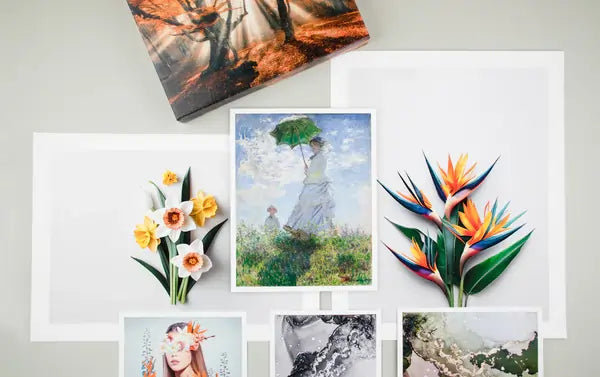Whether you are a photographer or an artist reproducing your work, understanding the difference between photography prints and fine art prints can help you choose the right product for your vision. While both can deliver beautiful results, they differ in materials, longevity, and overall presentation. Let’s explore what sets them apart and when to choose each type.
What Are Photography Prints?
Photography prints are designed to highlight clarity, vibrancy, and contrast. They are typically produced on photo-grade papers using high-resolution digital printers or traditional darkroom processes. At The Stackhouse Printery, our Giclée Photo Prints use professional Epson printers and premium resin-coated papers for striking image reproduction.
Common Photo Paper Types:
- Luster Photo Paper: Slightly textured finish that reduces glare while maintaining vivid color depth.
- Glossy Photo Paper: Bright and reflective surface that enhances sharpness and contrast.
- Metallic Glossy Photo Paper: Adds a pearlescent effect that makes colors appear dimensional.
- Photo Matte Fibre: Smooth, non-reflective surface with soft contrast for artistic presentations.
What Are Fine Art Prints?
Fine art prints are created using archival pigment inks on 100% cotton or alpha-cellulose papers. This process, known as Giclée printing, captures the full tonal range and texture of the original artwork. These prints are designed for museum-quality reproduction and long-term preservation, making them a top choice for galleries and collectors.
Popular Fine Art Papers:
- Hot Press Bright: Smooth matte surface ideal for illustrations and detailed artwork.
- Cold Press Bright: Textured surface resembling watercolor paper, great for paintings and mixed media.
- Photo Rag: Velvety matte paper offering deep contrast and soft tonal transitions.
- William Turner: Heavily textured surface for classic, tactile reproductions.
- FineArt Baryta: Glossy coating for photographs that need depth and definition with an elegant finish.
Photography Prints vs. Fine Art Prints: A Comparison
Here’s how these two print types differ in production, quality, and purpose:
| Feature | Photography Prints | Fine Art Prints |
|---|---|---|
| Printing Process | Digital or Giclée printing on photo papers | Archival Giclée printing on fine art papers |
| Ink Type | Dye-based or pigment inks | Pigment-based archival inks |
| Paper Composition | Resin-coated (RC) photo paper | 100% cotton rag or alpha-cellulose paper |
| Finish Options | Glossy, luster, matte, metallic | Matte, textured, or baryta (semi-gloss) |
| Longevity | Moderate lifespan (20–40 years) | Archival lifespan (100+ years) |
| Ideal Use | Portraits, commercial photography, décor | Fine art reproductions, limited editions, galleries |
When to Choose Each Print Type
Both printing styles have their place, depending on your project goals:
- Choose photography prints for vibrant, accessible works meant for décor, retail, or high-volume production.
- Choose fine art prints when detail, texture, and archival value are most important.
If you plan to sell limited editions, exhibit in galleries, or produce collector-quality pieces, fine art prints offer the best balance of visual depth and longevity. For photographers or brands creating large runs or promotional pieces, photo prints remain a flexible and affordable option.
Ready to Print Your Artwork?
At The Stackhouse Printery, we specialize in both photo and fine art printing using Epson’s 12-color UltraChrome PRO12 ink system. Order Giclée fine art prints today or request a free media sample set to see and feel the difference for yourself.




